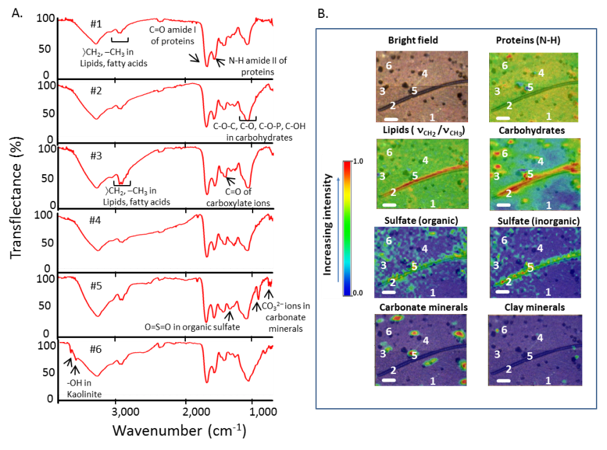In this application, SR-FTIR spectromicroscopy was used to unveil how archaea and bacteria work together and alter the sulfur and carbon cycles deep in a subsurface cold sulfur spring.
Archaea were first thought to be exclusively extremophiles – lovers of boiling hot springs, deep-sea black smokers, acid mine runoff, and other inhospitable environments – they are increasingly found thriving in moderate and cold environments, almost always as minority members of microbial communities. An exception to this pattern was discovered y. within microbial mats in outflow from a cold sulfur spring in Germany’s Sippenauer Moor, where Euryarchaeon outumbers bacteria. Together they formsymbiotic “strings of pearls”: the archaea fill the “pearls” and filamentous bacteria cover the pearl surfaces and form strings between them.
The two kinds of microbes were assumed to be syntrophic – dependent on each other for nourishment – but their biogeochemical roles remained a mystery. Christine Moissl-Eichinger of the University of Regensburg in Germany (and now at Medical University Graz, Austraia) and her team focused first on the bacterial fraction.
They linked phylogenetic diversity information with the spatial distribution of chemical and metabolic compounds by combining three different state-of-the-art methods: PhyloChip G3 DNA microarray technology, fluorescence in situ hybridization (FISH) and synchrotron radiation-based Fourier transform infrared (SR-FTIR) spectromicroscopy.
The results of PhyloChip and FISH technologies provide evidence for selective enrichment of sulfate-reducing bacteria, which was confirmed by detection of bacterial dsrB genes via quantitative PCR (qPCR) and sequence-based analyses.
They further established a differentiation of archaeal and bacterial cells by SR-FTIR based on typical lipid and carbohydrate signatures (see section 2.1.4, the method of Rapid Multi-dimensional Screening and Profiling of Microbial Communities), which demonstrated a co-localization of organic sulfate, carbonated mineral and bacterial signatures in the biofilm.
All these results strongly indicate an involvement of the euryarchaeal biofilm and sulfidic springs in sulfur and carbon cycles.
Moreover, these investigations of a bacterial minority in an Archaea-dominated environment are a remarkable example of the great power of combining highly sensitive microarrays with label-free infrared imaging.

